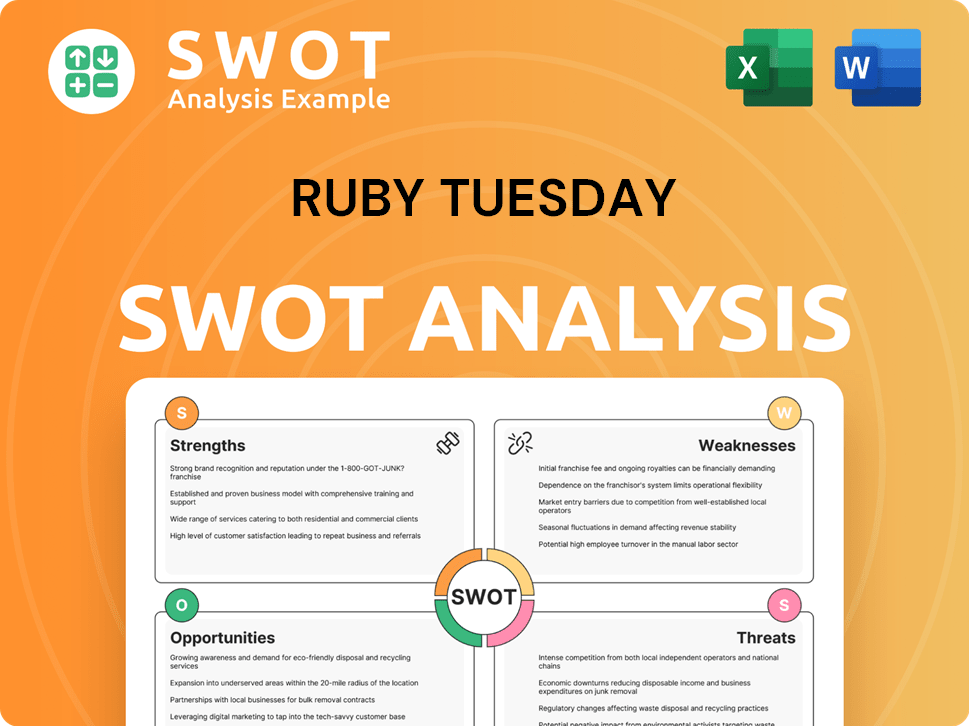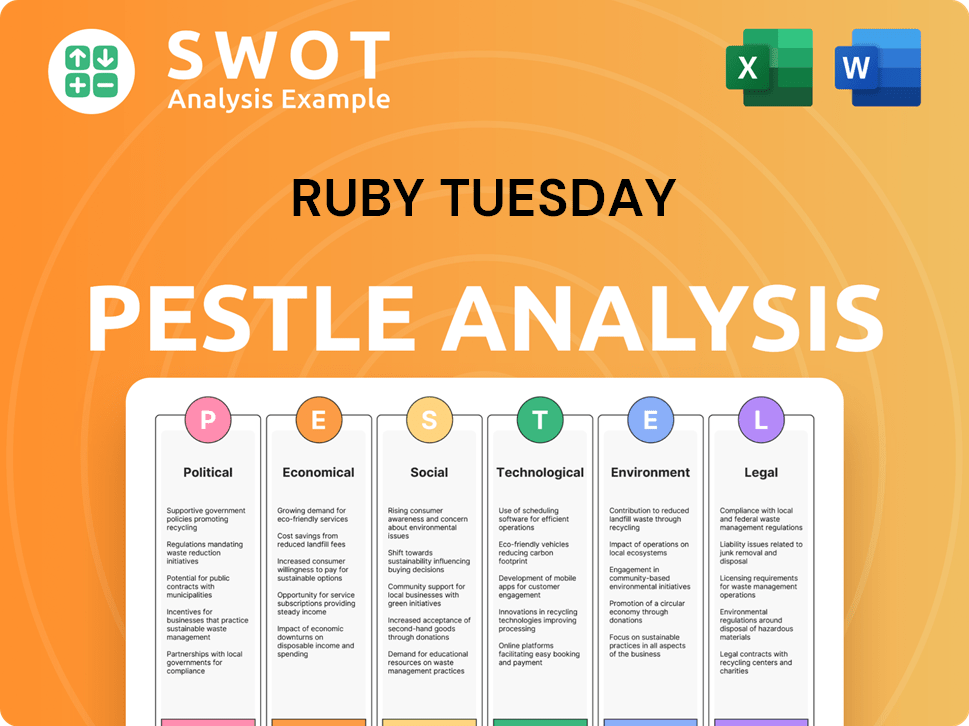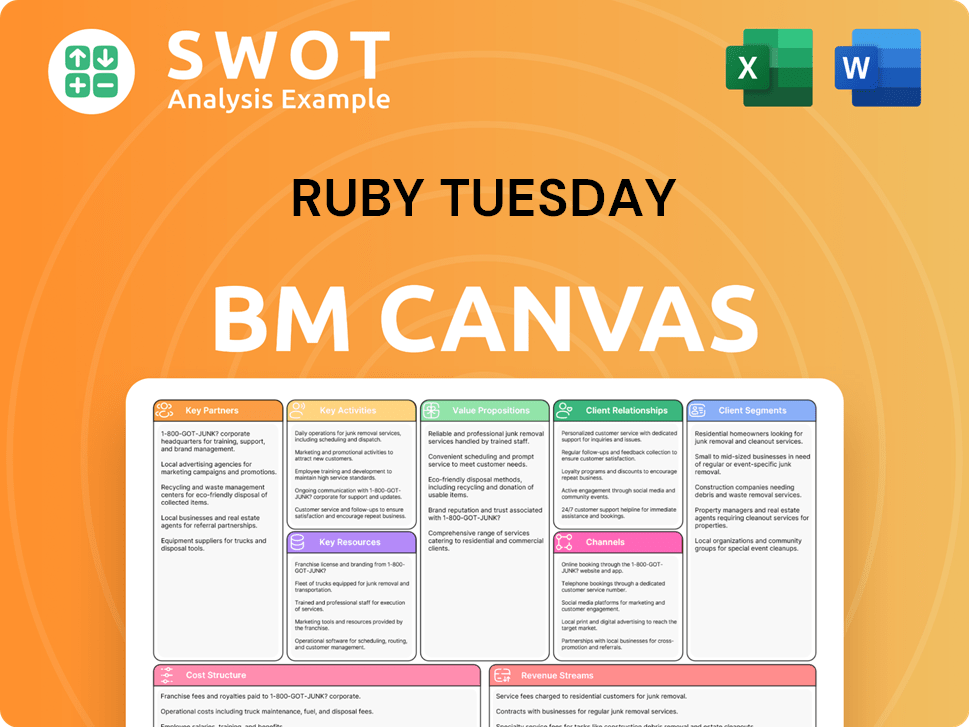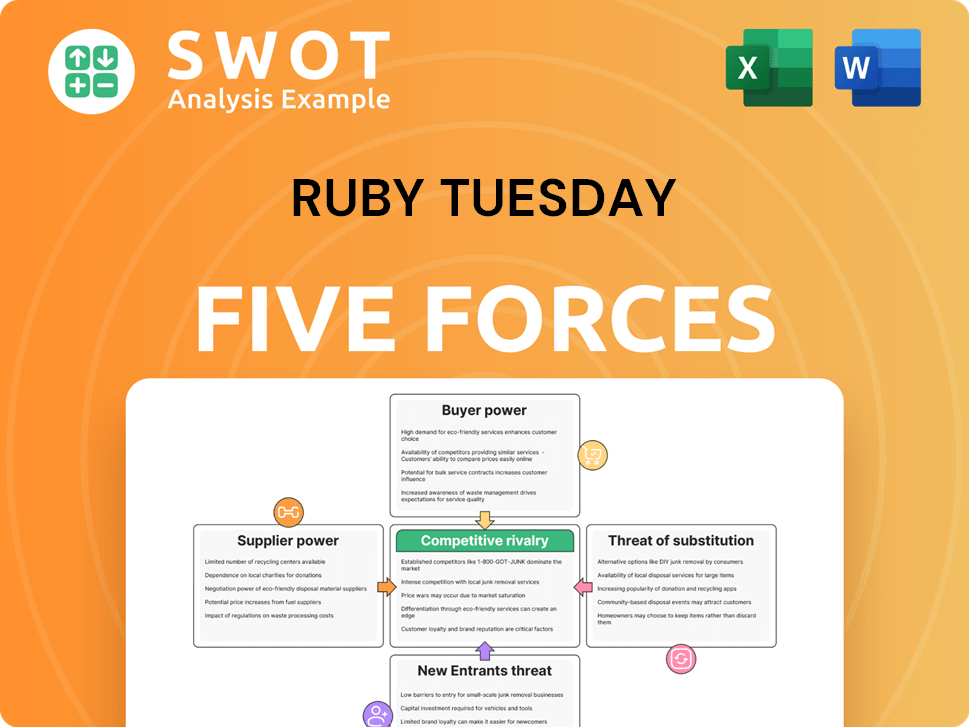Ruby Tuesday Bundle
Can Ruby Tuesday Thrive in Today's Restaurant Arena?
The casual dining sector is a battlefield of shifting consumer tastes and fierce competition. Ruby Tuesday, a long-standing player, has faced its share of challenges in this dynamic environment. This analysis explores the Ruby Tuesday SWOT Analysis, its rivals, and the strategies it employs to stay relevant.

Understanding the Ruby Tuesday competitive landscape is crucial for investors and industry watchers alike. This exploration will provide a comprehensive Ruby Tuesday market analysis, examining its position within the casual dining market. We'll delve into Ruby Tuesday competitors, evaluating their strengths and weaknesses while assessing Ruby Tuesday's competitive advantages and disadvantages to determine its future potential in the restaurant industry competition.
Where Does Ruby Tuesday’ Stand in the Current Market?
Ruby Tuesday operates within the fiercely contested casual dining sector. The company's core offerings center around American cuisine, including burgers, steaks, salads, and pasta, designed to provide a relaxed dining experience. This positions it to compete for customers seeking a sit-down meal in a casual setting.
The company’s value proposition focuses on providing a familiar and comfortable dining experience. It aims to attract a broad customer base with its menu. Despite challenges, Ruby Tuesday strives to maintain a loyal customer base by focusing on consistent quality and service within its established markets.
As of early 2023, Ruby Tuesday had approximately 209 locations, a significant decrease from its peak of over 800 restaurants. This contraction reflects a strategic shift in its market approach, moving from a broad national presence to a more concentrated regional footprint. The Brief History of Ruby Tuesday provides additional context on the company's evolution.
Specific market share data for Ruby Tuesday is not readily available due to its private status. However, the reduction in the number of locations indicates a decline in its overall market share within the casual dining segment. The company's reduced footprint suggests increased competition and strategic adjustments.
Ruby Tuesday's presence is now more concentrated in specific regions of the United States. This strategic focus allows the company to optimize its operations and resources. The company has closed underperforming locations, concentrating on markets where it can maintain a strong presence.
Ruby Tuesday operates in a highly competitive environment, facing off against larger chains like Darden Restaurants (Olive Garden, LongHorn Steakhouse) and Bloomin' Brands (Outback Steakhouse, Carrabba's Italian Grill). These competitors have greater market saturation and brand visibility. The casual dining market is subject to intense competition.
Industry analysts generally assess casual dining chains like Ruby Tuesday as operating in a challenging environment. The company's financial performance is influenced by factors such as consumer preferences, economic trends, and competition. Detailed financial data is not publicly disclosed due to its private ownership.
Ruby Tuesday's market position has evolved, with a reduced footprint compared to its peak. It competes with larger, well-established chains in the casual dining segment. The company's ability to maintain a loyal customer base and adapt to market changes is critical for its long-term success.
- Market Share Analysis: Ruby Tuesday's market share has decreased due to restaurant closures and increased competition.
- Competitive Strategies: The company focuses on operational efficiency and maintaining a core menu to retain customers.
- Differentiation: Ruby Tuesday differentiates itself through its American cuisine offerings and a focus on a relaxed dining experience.
- Target Market: The company targets a broad customer base seeking a casual dining experience.
Ruby Tuesday SWOT Analysis
- Complete SWOT Breakdown
- Fully Customizable
- Editable in Excel & Word
- Professional Formatting
- Investor-Ready Format

Who Are the Main Competitors Challenging Ruby Tuesday?
The Ruby Tuesday competitive landscape is shaped by a diverse array of rivals, both direct and indirect, within the restaurant industry. Understanding these competitors is crucial for assessing the company's market position and strategic challenges. This analysis provides insights into the key players influencing Ruby Tuesday's market analysis.
Direct competition primarily comes from established casual dining chains. These competitors often engage in aggressive marketing and promotional strategies to maintain and grow their customer base. The competitive environment is dynamic, with shifts in consumer preferences and economic conditions constantly reshaping the landscape.
Indirect competition includes fast-casual restaurants and the growing trend of at-home meal preparation. These alternatives offer consumers different value propositions, impacting the overall market dynamics. The restaurant industry is also affected by mergers and acquisitions, which create larger, more diversified companies.
Direct competitors include well-known casual dining chains. These restaurants compete directly for the same customer base, offering similar dining experiences and menus.
Applebee's is a significant direct competitor due to its extensive network and value-focused promotions. Their widespread presence and marketing efforts pose a considerable challenge to Ruby Tuesday.
Chili's is another key competitor, known for its Tex-Mex inspired menu and bar offerings. They compete for customers seeking a similar casual dining experience.
Outback Steakhouse, specializing in steakhouse fare, directly competes for customers seeking a menu centered around grilled meats. This focus allows them to target a specific market segment.
TGI Fridays also competes in the casual dining segment, offering a similar dining experience. They compete for a similar customer base.
These competitors often employ strategies such as price wars, loyalty programs, and menu innovation to attract and retain customers. These tactics are essential for maintaining market share.
Indirect competition comes from various sources, including fast-casual restaurants and at-home meal preparation. Fast-casual restaurants offer quicker service and perceived healthier options, appealing to convenience-seeking consumers. The rise of meal kit services and increased at-home cooking also impacts the restaurant industry competition. The impact of mergers and acquisitions, such as Inspire Brands' acquisition of Arby's, Buffalo Wild Wings, and Sonic, creates larger, more diversified restaurant groups with increased purchasing power and marketing capabilities, further intensifying the competitive landscape for standalone chains like Ruby Tuesday. New and emerging players in the digital ordering and delivery space also disrupt traditional dining patterns, forcing all competitors to adapt their service models.
Indirect competition includes fast-casual restaurants and the trend of at-home meal preparation. These alternatives offer different value propositions, impacting the overall market dynamics. The restaurant industry is also affected by mergers and acquisitions, which create larger, more diversified companies.
- Fast-Casual Restaurants: Panera Bread and Chipotle offer quicker service and perceived healthier options.
- At-Home Meal Preparation: Meal kits and increased home cooking trends also present competition.
- Mergers and Acquisitions: Inspire Brands' acquisitions create larger restaurant groups.
- Digital Ordering and Delivery: New players disrupt traditional dining patterns.
Ruby Tuesday PESTLE Analysis
- Covers All 6 PESTLE Categories
- No Research Needed – Save Hours of Work
- Built by Experts, Trusted by Consultants
- Instant Download, Ready to Use
- 100% Editable, Fully Customizable

What Gives Ruby Tuesday a Competitive Edge Over Its Rivals?
Understanding the Growth Strategy of Ruby Tuesday means analyzing its competitive advantages within the restaurant industry. Historically, the company has relied on brand recognition and its signature Garden Bar to differentiate itself. However, the casual dining market is dynamic, and maintaining these advantages requires continuous adaptation.
The company's brand, established over five decades, offers a degree of customer trust. The Garden Bar, featuring customizable salad options, has been a key differentiator. Operational efficiencies in menu management and supply chain, particularly for fresh ingredients, also play a crucial role. However, the competitive landscape is constantly evolving, with other restaurants introducing similar offerings.
To stay competitive, Ruby Tuesday must innovate and adapt to changing consumer preferences. The focus should be on maintaining a consistent dining experience and exploring new ways to attract and retain customers. This includes menu innovation and service improvements.
Ruby Tuesday benefits from decades of brand recognition, providing a foundation of customer trust. This familiarity is a key element in attracting and retaining customers in a competitive market. While brand equity can fluctuate, it remains a significant advantage.
The unlimited Garden Bar offers a unique selling proposition, providing a customizable and fresh salad experience. This feature appeals to customers seeking healthier or personalized dining options. The Garden Bar has been a significant draw for customers.
Operational efficiencies, including managing a diverse menu and supply chain, are crucial. Maintaining a consistent casual dining experience across locations contributes to customer loyalty. These efficiencies support the company's ability to deliver value.
The company faces challenges from imitation, as other restaurants introduce similar salad bar concepts. Evolving consumer preferences, favoring convenience and diverse culinary experiences, also pose a threat. Continuous innovation is necessary.
Ruby Tuesday's competitive advantages include brand recognition, the Garden Bar, and operational efficiencies. The brand's established presence provides a degree of customer trust. The Garden Bar offers a unique selling proposition within the casual dining segment.
- Brand Recognition: Decades of brand presence create familiarity.
- Garden Bar: Customizable salad options differentiate the brand.
- Operational Efficiency: Managing menus and supply chains effectively.
- Adaptation: Continuous innovation is essential to stay competitive.
Ruby Tuesday Business Model Canvas
- Complete 9-Block Business Model Canvas
- Effortlessly Communicate Your Business Strategy
- Investor-Ready BMC Format
- 100% Editable and Customizable
- Clear and Structured Layout

What Industry Trends Are Reshaping Ruby Tuesday’s Competitive Landscape?
The Ruby Tuesday competitive landscape is significantly shaped by evolving industry trends, economic conditions, and consumer preferences. The casual dining sector is experiencing a shift towards convenience, value, and health-conscious options, alongside technological advancements and regulatory changes. Understanding these dynamics is crucial for assessing the company's position, identifying potential risks, and evaluating future growth opportunities. A detailed Ruby Tuesday market analysis is essential to navigate the competitive pressures.
The company faces challenges, including declining foot traffic to traditional casual dining establishments and increased competition from fast-casual and ghost kitchen segments. Rising food and labor costs also squeeze profit margins. However, opportunities exist in leveraging technology, menu innovation, and strategic partnerships to enhance customer experiences and expand revenue streams. Analyzing the competitive environment helps in making informed decisions about Ruby Tuesday competitors.
The casual dining industry is seeing a surge in demand for convenience and value, influenced by digital platforms and delivery services. Health-conscious dining is also gaining traction, with consumers seeking transparency in food sourcing. Technological advancements, such as online ordering and loyalty programs, are reshaping customer expectations.
Declining foot traffic to traditional establishments, increased competition from fast-casual and ghost kitchens, and rising food and labor costs pose significant challenges. Adapting to changing consumer preferences and maintaining profitability in a price-sensitive market are also critical. Economic uncertainties and regulatory changes further complicate the landscape.
Leveraging technology for enhanced customer experiences, menu innovation with trending ingredients, and strategic partnerships with delivery services present opportunities. Exploring emerging markets and developing new restaurant concepts can also drive growth. Focusing on core strengths, like the Garden Bar, can differentiate the company.
Focusing on menu innovation, enhancing online ordering, and building strategic partnerships are key. Improving customer loyalty programs and ensuring operational efficiency are also crucial. A strong brand presence and effective marketing strategies are essential for success in a competitive market. Consider reading about the Marketing Strategy of Ruby Tuesday for more insight.
Ruby Tuesday must navigate the evolving casual dining landscape by adapting to consumer preferences and technological advancements. The company needs to address the challenges of declining foot traffic and rising costs while capitalizing on opportunities for growth through innovation and strategic partnerships. The company's success depends on its ability to differentiate itself and maintain a strong market position.
- Focus on menu innovation with trending ingredients and plant-based options.
- Enhance online ordering platforms and expand delivery services.
- Develop strategic partnerships for broader market reach.
- Improve customer loyalty programs.
Ruby Tuesday Porter's Five Forces Analysis
- Covers All 5 Competitive Forces in Detail
- Structured for Consultants, Students, and Founders
- 100% Editable in Microsoft Word & Excel
- Instant Digital Download – Use Immediately
- Compatible with Mac & PC – Fully Unlocked

Related Blogs
- What are Mission Vision & Core Values of Ruby Tuesday Company?
- What is Growth Strategy and Future Prospects of Ruby Tuesday Company?
- How Does Ruby Tuesday Company Work?
- What is Sales and Marketing Strategy of Ruby Tuesday Company?
- What is Brief History of Ruby Tuesday Company?
- Who Owns Ruby Tuesday Company?
- What is Customer Demographics and Target Market of Ruby Tuesday Company?
Disclaimer
All information, articles, and product details provided on this website are for general informational and educational purposes only. We do not claim any ownership over, nor do we intend to infringe upon, any trademarks, copyrights, logos, brand names, or other intellectual property mentioned or depicted on this site. Such intellectual property remains the property of its respective owners, and any references here are made solely for identification or informational purposes, without implying any affiliation, endorsement, or partnership.
We make no representations or warranties, express or implied, regarding the accuracy, completeness, or suitability of any content or products presented. Nothing on this website should be construed as legal, tax, investment, financial, medical, or other professional advice. In addition, no part of this site—including articles or product references—constitutes a solicitation, recommendation, endorsement, advertisement, or offer to buy or sell any securities, franchises, or other financial instruments, particularly in jurisdictions where such activity would be unlawful.
All content is of a general nature and may not address the specific circumstances of any individual or entity. It is not a substitute for professional advice or services. Any actions you take based on the information provided here are strictly at your own risk. You accept full responsibility for any decisions or outcomes arising from your use of this website and agree to release us from any liability in connection with your use of, or reliance upon, the content or products found herein.